by Winding Pathways | Feb 27, 2025 | (Sub)Urban Homesteading, Energy Efficiency, Trees/Shrubs
After lots of experimenting, we’ve figured out how to create the best woodstove fire.

Wood heat is lovely
For a half century, our stoves kept us warm during winter’s chill. We’ve burned all sorts of wood, ranging from rather low-heat cottonwood to heat-dense black locust. We prefer using a mix of wood from different species to create and maintain the best warming fire.
Sources
The Internet is packed with charts giving the relative heat value of wood based on species. These are great resources that help choose the best wood species. All the charts assume that every species is dried to about the same moisture contact to make accurate comparisons. When given a choice it’s generally the best use of time and storage space to choose dense woods that have high heat value. But we make great use of lower-value woods like pine and cottonwood.
Curing
No matter the species, wood needs to be cured to make efficient firewood. We cut and split our wood and store it out of the rain for at least two years.
Trees Felled
In August 2020 a derecho’s 140 mile an hour wind felled 47 trees on our property. It made a mess. We hated losing shade and privacy but converted the downed trees into cordwood that’s kept us warm for the past four winters. The wind knocked down Douglas Fir, Black and Red Oak, Mulberry, Black Cherry, White Pine, Hackberry and American Elm. We use them all in slightly different ways.
Different Woods
Here’s how different types of wood burn and how to take advantage of their different characteristics.
Woods with Pitch

Douglas Fir has lots of pitch.
Pine and Douglas Fir: These softwoods contain pitch. Highly flammable turpentine is made from pine pitch. It burns like crazy. We split our White Pine into kindling. Finely split shavings are easy to light with a match even without using paper. Once the fire is going, we avoid burning smoky pine.
Our Douglas Fir is denser and harder than pine and holds more heat per pound. It also contains pitch. So, when starting a fire on a cold morning we put a large chunk of Douglas Fir in the woodstove, lean pine shavings against it, and strike a match. Soon the shavings are burning hot enough to ignite the Fir’s pitch and get a hot fire started.
Putting too much kindling or pitch-filled wood in a stove can be dangerous. It burns very hot with a yellow flame and some smoke. So, we don’t load the firebox with the stuff.
Hardwoods

Three types of hardwood.
Oak, Cherry, Hackberry, and Elm: These hardwoods lack pitch but are loaded with heat released during combustion. We put these woods on our chunk of burning Douglas Fir and keep adding them all day. They create a mellow burn that releases heat more slowly than softwoods. The Engineering Toolbox has excellent information on relative values of wood heat.
Relative Heat Values
Here are some relative heat values of the woods we burn.
Species BTU’s Per Cord Cord Weight
Red Oak 24 million 3760
Black Cherry 20 .. 3520
White Pine 14.3 .. 2240
Douglas Fir 26.4 .. 2970
Cottonwood 15.8.. 2272
Benefits of woodstoves
Burning wood saves money and provides ultra-comfortable heat, but it takes plenty of work to find, cut, split, move, and stack it. Then it has to cure and be moved close to the stove. To us, the work and patience have been well worth it, especially on frigid snowy nights.
-

-
Summer project.
-

-
Storing wood.
by Winding Pathways | Jan 30, 2025 | (Sub)Urban Homesteading, Energy Efficiency
Radon is an unwelcome house guest that we’re careful to boot out. We welcome wild turkeys, barred owls, and a local opossum to visit but radon comes uninvited.
Our house was built in 1947 atop an ancient sand dune formed when the glaciers receded around 9,000 years ago. Fierce Southwest winds blew sand from the Cedar River up to where our house was built thousands of years later. Down in that sand or the rock beneath it is uranium. As it degrades it turns into radon that percolates up and enters our house.
Noble Gas
Physicists consider radon a noble gas, but there’s nothing noble about what it can do to human health. Radon is a stealthy gas that is odorless, invisible, and tasteless. It’s the number two cause of lung cancer in America behind smoking.
Mitigating Radon
When we bought our home in 2010 the former owner had just installed a radon mitigation system. Basically, it’s a fan that vents radon outside. The gas has a half-life of only 3.8 days. That means half of it will have degraded into potentially nasty polonium in about four days. However, these gasses are diluted and break down quickly and pose little danger outside a building. Eventually, they further degrade into lead.
Alpha Emitter
Radon is a radioactive alpha emitter. A single sheet of paper can stop its particles. The particles are dangerous when breathed in and lodged in the lungs. There they can cause lung cancer.
Prevention
Prevention is simple and involves venting radon from the house to the outside. On a December morning Neil McDonald, a licensed radon mitigation specialist, visited Winding Pathways. He replaced our worn-out radon fan with a new one that has more oomph.
“Any house built after 2015 likely has a radon venting system built into it that channels the gas outdoors. Probably the majority of older houses have some radon inside and lack a mitigation system. Radon can be anywhere but many areas of the country have especially high concentrations of it and the Midwest is one of the worst regions,” he said while he replaced our fan.
-

-
Simple replacement
-
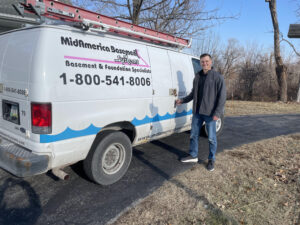
-
Neil McDonald, Radon mitigation specialist
Test Kits
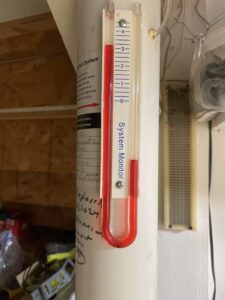
Uneven is good.
A few years ago, we wondered if our radon removal system was working so we bought two test kits at a local home store. We ran a test with our system going and mailed it to a lab. It showed a pcl/L level under 2. Then we turned the system off and retested it. Radon levels were about 5. Our system works! The government recommends action in any building with a level of 4 or above. Test kits and electronic testing devices can be purchased at many home improvement and hardware stores.
When Is Radon Most Concentrated?
“Radon tends to be most concentrated in homes during the summer and winter when windows are closed and furnaces or air conditioners are running. Generally, levels are lower in spring and fall when people keep their windows open, allowing the gas to flow outside. Concentrations are usually highest in basements,” he continued.
Replacing the Machine is Part of Our Maintenance
We knew our old radon fan was on its last legs when its noise level increased. That’s when we invited Noel to visit and install a new fan. Switching it out only took about an hour.
Helpful Sites
Helpful information on radon can be found at the Environmental Protection Agency’s website. Googling Radon Mitigation takes a person to many sources. For Iowans, Health and Human Services is a helpful site. Our tax dollars doing good work to keep people safe. Radon mitigation companies operate in nearly all larger towns. We hired MidAmeria Basement Systems to replace our fan.
Making sure radon is not a problem is similar to having health checkups and cleaning the woodstove and gas fireplaces. Maintenance! We continue to welcome our wild turkeys and possums to our yard while kicking radon out of the house.
by Winding Pathways | Dec 5, 2024 | (Sub)Urban Homesteading, Energy Efficiency, Garden/Yard, Garden/Yard
*Note: Below are just a few examples of several power tools we’ve purchased. They were pricey but made yard work so much easier than with muscle-powered tools. Occasionally, a company asks us to try a product and give reviews.
Yard work was a snap when we were in our 20s. That was a half-century ago! How can that possibly be? Years slipped by. We’re just as eager to mow grass, rake leaves, plant gardens, prune shrubs, and shovel snow, but muscles and joints make the work challenging. Fortunately, we’ve found ways to make yard work and house repairs easier for us as aging homeowners. People with reduced strength or mobility and even younger people with busy schedules will find these tips handy.
Here are some ways we’ve made yard management easier:
Invest in Tools
Tool companies have made yard care easier and safer than in the old days. We used to use muscle-powered tools to trim hedges and shrubs, cut and split wood, rake leaves, move snow, and till the garden. As we got older we began investing in power tools that make the work easier and faster.
For example, an old fashioned “weed wacker”, powered by arm muscles, cut down tall grass growing into pathways and our woods. That got harder each year, so we invested in a Milwaukee brand battery-powered tool that fuels a weed cutter, pole saw, and hedge trimmer. The work is quick and easy. Same with our lopping shears for trimming trees. A battery-powered pruner does the tough cutting easier than hand muscles.
-
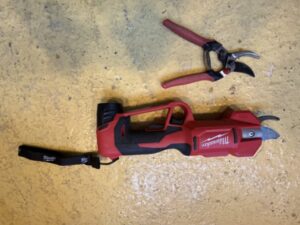
-
spring loaded vs battery
-
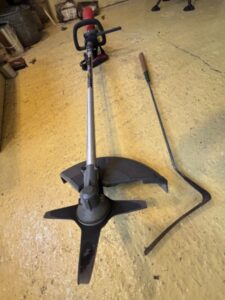
-
Long handle
-
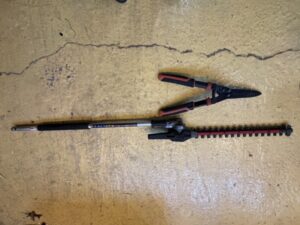
-
Muscle powered shears next to hedge trimmer.
We always had a gas lawn mower but often struggled to pull the darn starter cord. When EGO came up with a battery-powered mower we eagerly bought one and got rid of the old gas mower. The EGO starts by pushing a button, and it’s self-propelled. We have to walk behind and guide it, but it chugs along under its own power. That’s especially helpful when we mow trails on our hillside.
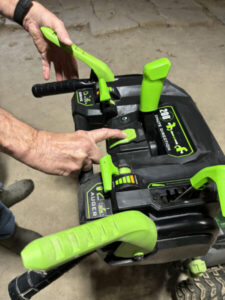
The EGO snowblower starts with a push of a button.
Snow shovels! Well, we still have a few and use them in tight spaces, but our relatively new battery-powered snow blower makes clearing our 440-foot driveway a snap and eliminates the need to lift heavy snow and pull a starter cord.
Those are just a few examples of several power tools we’ve purchased. They were pricey but made yard work so much easier than with muscle-powered tools.
Hiring and Borrowing
This past season we did a “first”. We hired a young woman to help with gardening. And, we sometimes hire a local teenager to mow our lawn. Years ago we wouldn’t have dreamed of hiring anyone to do what we could do. That’s changing. Having extra hands to help is money well spent.

The tractor made hauling wood easier.
It’s not always hiring help. We swap. By late October Rich had cut and split a small mountain of cordwood we’ll use to stay warm this winter. There was a problem. It was on the north side of our property and down a steep hill. In past years he’s hand carried it uphill. Not a small task to muscle 2000 pounds of wood in 50 round trips carrying 40 pounds up the hill each time. Whew. This year a neighbor came to our rescue. Rich borrowed his tractor and trailer and moved all the wood up the hill in a jiffy. From time to time, we have loaned him some of our tools in exchange. Borrowing works both ways.
We pride ourselves on our independence and take joy in yard work, but we just turned 75 and aren’t quite as frisky as we once were. Using power tools, hiring help, and cooperating with neighbors all make keeping up with the yard easier.
by Winding Pathways | Jun 20, 2024 | (Sub)Urban Homesteading, Energy Efficiency, Nature, Trees
Connecting With Wood
Although we rarely watch sports on TV, the 2024 Iowa Women’s Basketball team captivated us. With athletic sneakers squeaking up and down the wood floor, Caitlin Clark’s sharpshooting and Hanna Stuelke’s blocks were amazing.

ICCU Arena Photography by Lara Swimmer. Images use restricted. Use by permission only.
About a month after the season, we entered an elite new basketball arena. Neither Caitlin nor Hanna was there, but we bet they’d love playing in a gorgeous new venue crafted mostly of wood. It’s on the University of Idaho campus.
“The arched ceiling beams are strong, beautiful, and crafted of local Douglas Fir and larch,” said Dean of the University’s College of Natural Resources, Dennis Becker, as he guided us through the University’s Idaho Central Credit Union (ICCU) Arena. It opened in October 2021 after about two years of construction and several more of planning and fundraising. Remember, this was during the Pandemic!
Modern, Flexible, and Beautiful Venue
After playing in the nearly century-old Memorial Gym and a few years in the massive Kibbe Football Dome, the University sought to create a gorgeous and flexible venue that enabled players and spectators to enjoy the intimacy of a largely wooden building that connects spectators with nature. Building it drew on the college’s academic strengths in forestry and wood technology, architecture, engineering, and athletics.
“Much of the wood used to create it came from the University’s Experimental Forest. In addition to being elegant its beams of laminated wood are sturdy, fire resistant, and gorgeous,” continued Dean Becker.
-

-
Logging and Maintenance at the Experimental Forest
-

-
Selective logging
The Dean later explained that the reason the building feels warm and comfortable may be a concept expressed by Erich Fromm to describe the biological orientation humans have with all that’s alive and vital. Biophilia was expressed by the late Harvard professor E.O. Wilson as an affiliation people have with other life forms and nature as a whole, which is rooted in our biology.
-

-
Gorgeous and modern
-

-
Courtside in background
-

-
Variety of woods
Connecting to Wood
Perhaps biophilia made us feel comfortable immediately after entering the Arena as it does in our Iowa home. In both places, we enjoy being enveloped in wood.
We recently visited friends in their brand-new home. Although functional and low maintenance, something about it was mildly uncomfortable. Crafted almost entirely of human-made products the home had doors of plastic, flooring of artificial planking, and walls of plaster. Even the cabinets were plastic. It lacked wood.
In contrast, our 1947-era home replete with wood feels cozy. Floors are white oak and Douglas fir with beams and rafters of pine, fir, and cedar. Our tables were crafted from red oak and black walnut and on the fireplace mantle is a polished cross-section of an oak crotch and a leaf carved from silver maple wood.
What Is It About Wood?
We love wood. It’s gorgeously individualistic. No two boards are exactly the same. It projects a warm and comforting feeling while having environmental benefits. Sustainably managed forests allow land to continually produce wood forever. It is also easy to reuse or repurpose.
Last winter we hired a company to refurbish our downstairs bathroom of easy-to-clean plastic and vinyl. It functions well, but something about it didn’t feel right. No wood. So, Rich bought a half-inch thick oak board, cut it to fit, finished it with a soft finish, and nailed it to a ceiling beam. That single piece of wood made the bathroom more comfortable.
Whether in a home or the University of Idaho’s Idaho Central Credit Union Arena, the beauty and function of wood make us feel at home.
-

-
ICCU Arena exterior drone shots
-

-
ICCU Arena photography by Lara Swimmer. Images use restricted. Use by permission only.
This is one of a three-part series of blogs stemming from a recent visit to our alma mater, the University of Idaho. The school offers an array of majors and is located in the rolling farmland of the Palouse and nestled below Moscow Mountain. For information check out uidaho.edu. Its College of Natural Resources offers majors ranging from wildlife biology to outdoor recreation, and forestry. It’s where Rich graduated. Marion received her MS from the Idaho College of Education, which features a variety of degrees, including movement science.
by Winding Pathways | Aug 17, 2023 | (Sub)Urban Homesteading, Energy Efficiency, Labyrinths, Nature
Coralville’s Unitarian Universalist Society Members
Live What They Profess
In the middle of a worldwide heat wave that scientists declared resulted, in part, from human-caused climate change, we entered the campus of the Greenest Church in Iowa, the Unitarian Universalist Society in Coralville, Iowa. Feeling depressed by climate change news, the visit buoyed our spirits and gave us a glimmer of hope for the future of our planet.
One of the Unitarian Universalists’ principles is respect for the independent web of all existence of which we are a part of. The members of the Coralville church live the principle and others that form their core beliefs.
The Greenest Church in Iowa
As we turned into the Church campus, everything was softer and quieter. We drove past rows of photovoltaic solar cells. Just past them was a world of green. Nestled within native vegetation was a lovely contemplative labyrinth. A vegetated detention basin is both the home for pollinating insects and a place to catch stormwater, preventing it from scouring its way downhill.
We walked a delightful path circling the organization’s eight acres. Native flowers were alive with pollinators, and a children’s play area was meshed into nature. It’s almost as if this location were meant to be.
-

-
south facing solar panels
-

-
Water slows down as it percolates through the bioswale.
-

-
Families outside
On entering the building, the Church’s low ceiling entry opens into expansive spaces, an echo of Frank Lloyd Wright’s style. An immediate sense of calm and comfort enveloped us. Just beyond the cozy foyer, our eyes were drawn upward. East-facing windows framed an Iowa summer sky dotted with puffy clouds. Outside, deep green pines swayed in a gentle breeze. Members greeted us and Sally Hartman, chair of the Social Justice team, hosted us during the service. Worship leaders were engaging, the acoustics excellent, and the presence of the outdoors through the windows soothed us.
-

-
A lovely, open space
-

-
Visuals and audio enhanced the service.
-

-
Living the mission
How Did This Come to Be?
Depending on one’s perspective, this church and location have been in the making since the 1990s. More recently since 2013. Sally, also a member of the Iowa UU Witness Advocacy Network, and Kirk Witzberger, who served on leadership teams that developed and implemented the plans, explained. Over many decades, the Society recognized that even with renovations, the former Gilbert St. site in downtown Iowa City could not meet 21st Century needs. Different teams looked for new property. After an almost certain deal for another property fell through, a member happened to chat with a realtor who mentioned the current site. The Congregation voted overwhelmingly to buy and the couple who owned the land, former Peace Corps volunteers, were delighted to sell to an organization that respected the land.
Multiple meetings and myriad decisions followed. The result is a beautiful net zero building that the congregation shares with the community. The building burns no fossil fuel. Solar energy produces all its energy needs, including lighting, heating, and cooling.
Efficient and Flexible
The building includes a sanctuary, gathering spaces, offices, classrooms, and food service areas. Tucked into the property, it fits well. As attractive as its outdoor vegetation is, the building was well thought out. Just a few examples include:
- Efficient glass walls boost energy efficiency while allowing people inside to feel like they’re sitting in nature. We enjoyed watching clouds drift by during the service we attended.
- Flexible space can accommodate large groups of up to 600 or be compartmentalized into smaller, more intimate gathering places.
- All areas are easily accessible for folks with walking challenges. Even carpets are precisely flush with adjoining harder floors.
When we asked Kirk Witzberger, who was instrumental in the transition to this location, what the utility bill is he said, “We don’t have one. This is a zero net energy building…..it produces all its energy needs.” For members of an organization to live as lightly on the land as possible is impressive!
-

-
Free food and books.
-

-
Soft lighting directs footsteps.
-

-
Efficient east-facing windows let in light and bring a sense of nature inside.
-

-
Greenery softens the outside scape.
Living Other Principles
The Coralville Unitarian Universalist Society members live their commitments in other ways, too. Members take turns recycling compostable materials. When outside groups rent the space, they agree to a contract of sustainability – i.e. use only recyclable materials. The church is investigating how to be a “cool” refuge in summer and a “warm” refuge in winter. Further, members are researching ways they can offer a safe learning space for marginalized youth with activities like art and music. Members have held summer Nature Camps and environmentally-themed Trunk and Treats, and sponsored an environmental fair designed to raise awareness and action in caring for our world.
Inspiring Model
After touring the building and grounds we wondered why the model of the Unitarian Universalist Society isn’t more common in society. It should be. If people associated with all buildings everywhere did what they could to produce their energy needs through renewable sources the threat of climate change would be muted and our children could look forward to a cleaner and safer world.
Want to visit? The Church welcomes you. Details are on their website.
by Winding Pathways | Jun 1, 2023 | (Sub)Urban Homesteading, Energy Efficiency
Mumbo Jumbo
“That solar stuff is just a bunch of mumbo jumbo,” said the passenger sitting next to Rich on a recent flight from Newark, New Jersey, to Charlotte, North Carolina.
As the plane climbed over urban New Jersey, he could see solar collectors on large flat roofs below the plane. When it descended into Charlotte no solar was visible on similar buildings. Rich’s seatmate was a man from the Charlotte area who told him that solar is mumbo jumbo.
We LOVE this type of Mumbo Jumbo!
Really! Our May 2023 electric bill showed that we owe our utility $12.51. The average Iowa home’s monthly electric bill is $145. Ours is $132.45 lower. That’s neither chump change nor mumbo jumbo.
Our bill is low because we’re careful to turn off electric-consuming devices not in use, and when buying new appliances, we opt for efficient models. We installed a small net-metered solar system seven years ago. It cost about $9,000 but tax credits brought our cost to about half that. We’re reaping Solar’s benefits through reduced electric bills, and our system is projected to last at least 25 years.
Industrial and Commercial Uses

Peoples church installed solar panels after roof repairs and upgrading lights and HVAC.
Solar also disproved mumbo jumbo at Peoples Church Unitarian Universalist in Cedar Rapids. A solar electric system was installed in the fall of 2021. For the prior year monthly electric bills averaged $226. After solar it was $60 but about half of that was the cost of a leased parking lot light. When it was removed the Church’s monthly electric cost dropped to $22. That’s hardly mumbo jumbo.
Practice Conservation to Increase $ In Your Wallets
Some considerations need to be taken into account. These can be overcome when you want to install solar. A recent news article revealed that even people with average incomes lack $400 ready cash for emergency needs – i.e. a new appliance. So, families and businesses, schools and churches need to practice cost conservation from the “git go”. Replace inefficient lights. Turn off lights, especially those energy hog outdoor and yard lights. You don’t need them! Install motion sensors in areas such as classrooms, restrooms, and offices. Turn OFF computers when you are not using them. Leaving them on is just plain lazy. Unplug “vampire” appliances like toasters and coffee pots. They quietly wolf down energy spiking your bills. Turn off and drag up from the cellar that inefficient old freezer/refrigerator or stove. Alliant Energy gives you $ for these dinosaurs. Save that for buying a solar system. You end up with more space, less waste, and money in your pocket. Before you swap out air conditioners for an efficient one caulk your home to plug leaks. Other ways exist to save money and then save for solar. It is worth it.
Look Around for Examples That Disprove Mumbo Jumbo
Thanks to the declining cost of solar and new Federal tax credits, installing solar is a wise financial investment that reduces both bills and fossil fuel emissions. It is NOT mumbo jumbo.
-
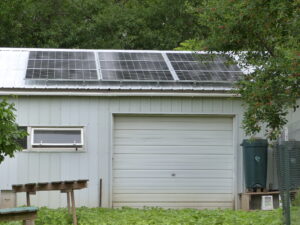
-
Solar powers our home and the light needed for the coop.
-

-
The main building of the Leopold Center has Platinum LEED designation. mn
-

-
First net-metered solar panels in the state.



































